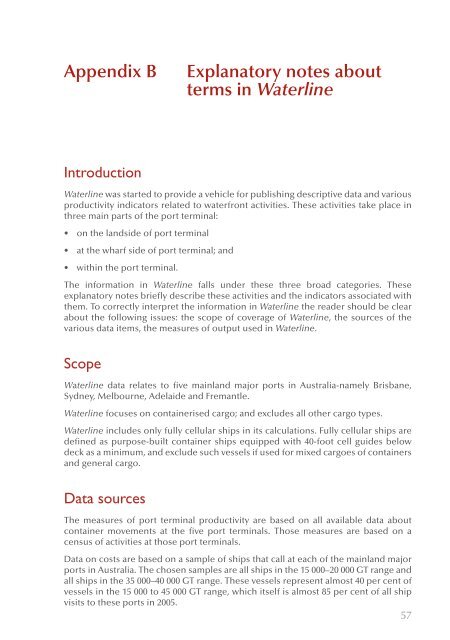PDF: 1352 KB - Bureau of Infrastructure, Transport and Regional ...
PDF: 1352 KB - Bureau of Infrastructure, Transport and Regional ...
PDF: 1352 KB - Bureau of Infrastructure, Transport and Regional ...
- No tags were found...
Create successful ePaper yourself
Turn your PDF publications into a flip-book with our unique Google optimized e-Paper software.
Appendix BExplanatory notes aboutterms in WaterlineIntroductionWaterline was started to provide a vehicle for publishing descriptive data <strong>and</strong> variousproductivity indicators related to waterfront activities. These activities take place inthree main parts <strong>of</strong> the port terminal:• on the l<strong>and</strong>side <strong>of</strong> port terminal• at the wharf side <strong>of</strong> port terminal; <strong>and</strong>• within the port terminal.The information in Waterline falls under these three broad categories. Theseexplanatory notes briefly describe these activities <strong>and</strong> the indicators associated withthem. To correctly interpret the information in Waterline the reader should be clearabout the following issues: the scope <strong>of</strong> coverage <strong>of</strong> Waterline, the sources <strong>of</strong> thevarious data items, the measures <strong>of</strong> output used in Waterline.ScopeWaterline data relates to five mainl<strong>and</strong> major ports in Australia-namely Brisbane,Sydney, Melbourne, Adelaide <strong>and</strong> Fremantle.Waterline focuses on containerised cargo; <strong>and</strong> excludes all other cargo types.Waterline includes only fully cellular ships in its calculations. Fully cellular ships aredefined as purpose-built container ships equipped with 40-foot cell guides belowdeck as a minimum, <strong>and</strong> exclude such vessels if used for mixed cargoes <strong>of</strong> containers<strong>and</strong> general cargo.Data sourcesThe measures <strong>of</strong> port terminal productivity are based on all available data aboutcontainer movements at the five port terminals. Those measures are based on acensus <strong>of</strong> activities at those port terminals.Data on costs are based on a sample <strong>of</strong> ships that call at each <strong>of</strong> the mainl<strong>and</strong> majorports in Australia. The chosen samples are all ships in the 15 000–20 000 GT range <strong>and</strong>all ships in the 35 000–40 000 GT range. These vessels represent almost 40 per cent <strong>of</strong>vessels in the 15 000 to 45 000 GT range, which itself is almost 85 per cent <strong>of</strong> all shipvisits to these ports in 2005.57
















